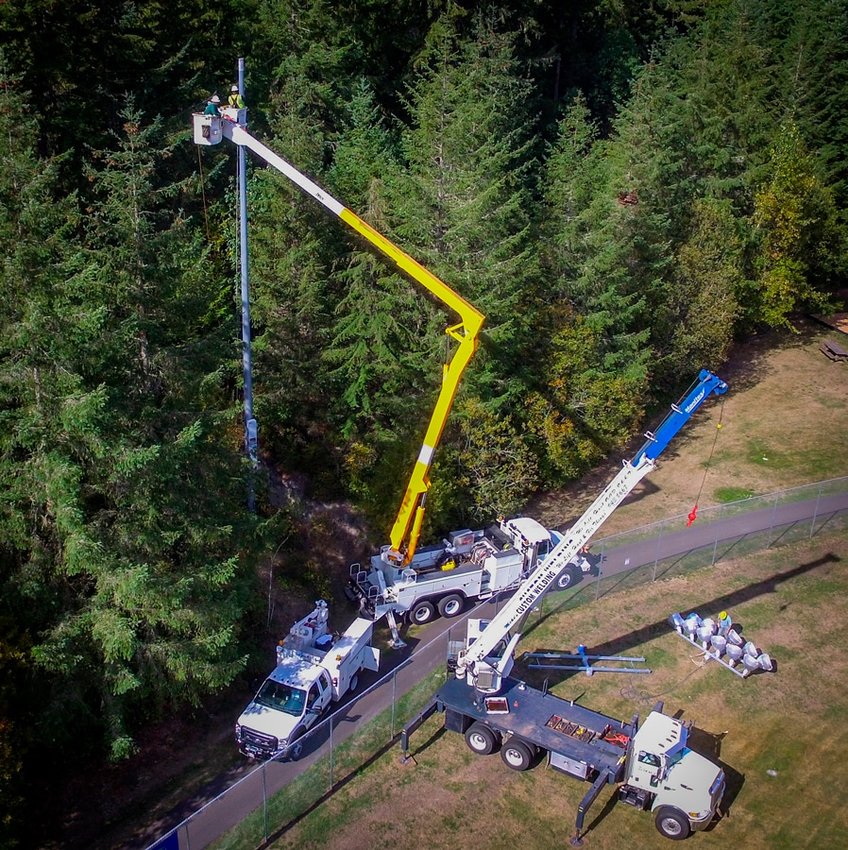 Key Pen Parks replaced the ball field lights at Volunteer Park with new LED fixtures with the help of Penlight linemen and bucket trucks to remove the old fixtures and replace them with new, brighter and more energy-efficient ones. Photo: Peninsula Light Company
Key Pen Parks replaced the ball field lights at Volunteer Park with new LED fixtures with the help of Penlight linemen and bucket trucks to remove the old fixtures and replace them with new, brighter and more energy-efficient ones. Photo: Peninsula Light Company
Just over 90 years ago, Jan. 8, 1927, electricity flowed for the first time on the west side of the Tacoma Narrows. Peninsula Light Co., which now has more than 1,000 miles of line and 32,000 meters in Gig Harbor, Fox Island and on the Key Peninsula, has come a long way.
In 1924, the state issued Peninsula Light Co. a license to operate. A year later, the articles of incorporation were adopted and the company, a nonprofit cooperative, was established. Members paid $100—worth $1,400 in today’s dollars—to join.
The budget was tight: In August 1925, the board approved purchase of a binder for the meeting minutes “if the price was reasonable.”
In December 1926, PLC was officially energized with power supplied by Tacoma City Light, but operation apparently ceased when funds ran out. Board members began membership drives and personally collected the memberships. For those who could not pay the $100 membership, an in-kind option was available: installing a pole was credited at $5.
The drive was successful and three months later 55 miles of line were up.
PLC, now Peninsula Light Co., was ahead of its time. According to America’s Electric Cooperatives website, the electric cooperative movement came into full force in the 1930s. The Rural Electrification Administration was established by the Roosevelt administration to provide federal loans to serve sparely populated rural areas. Investor-owned utilities were not interested, but loan applications from farmer-based cooperatives poured in, and ultimately electric cooperatives made rural electrification a reality. They continue to provide power to most rural communities.
Jafar Taghavi, who has been Peninsula Light Co.’s chief executive officer for 10 years, described the benefits of the cooperative structure. “We are owned by the community,” he said. “This means we are here to benefit the community and not stockholders.” All members pay membership—it is still $100—at the time they sign up for service. It is refunded when the member leaves.
He said the board structure assures that the board works for all members and not any special interests. Nine members are elected at-large to three-year terms, with election of three members each year
Board President Signo Uddenberg said, “We are extremely proud of our accomplishments. Peninsula Light’s rates remain among the lowest in the region even while we maintain the top quartile in the nation for reliability. In addition to this, our member services department consistently rates among the best in the nation for customer service.”
Taghavi said that Peninsula Light’s focus on customer service and reliability have especially paid off in the last seven to eight years. Reliability is measured by the frequency and duration of outages, and since 2010 the ranking has gone from the bottom quartile to the top quartile.
“Staying in the top quartile is harder than getting there in the first place,” he said, noting that all companies continually work to improve. “Our customers have high expectations.”
Lines were undergrounded wherever economically feasible, Taghavi said, with about 700 miles completed. For those lines where poles were still in place, bare conductors were replaced with insulated conductors. “About 80 percent of power outages on poles are caused by branches falling across lines and shorting them out. Insulated conductors prevent that,” he said.
Finally, technology has been critical. “We are not at the bleeding edge, but we are at the cutting edge of technology,” Taghavi said. In 2005, the company began installing automatic meter readers. They provide two-way communication over the power lines, eliminating the need for meter readers, but also provide a way to troubleshoot and analyze outages and to confirm power restoration.
Peninsula Light does not plan to enter the telecommunications business, Taghavi said, though it did install extra conduit when the undergrounding took place to accommodate fiberoptic cable in the future. Currently, CenturyLink, Wave and Comcast participate in a Joint Pole Agreement where they rent access maintained by Peninsula Light.
Peninsula Light does more than provide electricity.
In 1995, it entered the water business, managing or owning class A and B systems. They are responsible for about 3,000 systems, including Key Center and the school district, taking care of billing and testing.
Taghavi is also proud of the role Peninsula Light has played helping people in its service area. Its Community Support Fund provides $50,000-60,000 a year to various programs and Project Help matches up to $80,000 a year to help customers in need pay their electric bills.
UNDERWRITTEN BY THE FUND FOR NONPROFIT NEWS (NEWSMATCH) AT THE MIAMI FOUNDATION, THE ANGEL GUILD, ADVERTISERS, DONORS AND PEOPLE WHO SUPPORT INDEPENDENT, NONPROFIT LOCAL NEWS